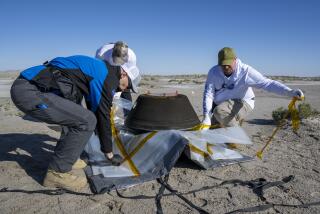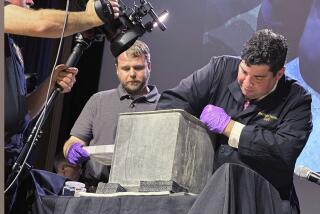A Present to Future
- Share via
Fully in tune with the times, Larry and Caroline Rober of Brea turned to the Internet to satisfy their need to make a mark in the new millennium.
Online, they bought a time capsule.
The glistening stainless steel tube, nearly a foot long and 3 1/2 inches in diameter, is to be packed with mementos and letters to their children and then stored in an attic trunk until the couple have died. Caroline Rober said she learned the importance of such a step from the grandmother who raised her.
In a collection of belongings passed down, “I found the key chain that she carried. It’s part of her that’s with me, and it reminds me of all the wonderful things she taught me and how she loved me,” said Rober, 47. “Someday my children or great-grandchildren will want that feeling of security and being connected.”
Experts say the advent of 2000 has prompted thousands of families--as well as schools, companies and other institutions--to send similar messages to the future.
From two toilet bowls clamped together to a coffee can buried in a backyard to an enormous airtight polymer container tucked in the cornerstone of a building, time capsules are experiencing a boom in popularity as the millennium gets ready to wrap.
Purists scoff that many capsules sold online or in stores are cheap substitutes for the real thing that will not protect their contents very far into the future. But no one denies that they appeal to people on a very basic level.
“Time capsules spring from the urge to propagate the self,” said Gregory Benford, a UC Irvine physics professor, science fiction writer and author of the book “Deep Time: How Humanity Communicates Across Millennia.”
There’s something almost primal about it, says Paul Hudson, founder of the International Time Capsule Society.
“Any kid who has buried treasure understands that,” he said. “Anyone who has stuck one’s hand in wet cement would know the feeling. It’s the sense of immortality.”
Time capsules give future generations a glimpse of the pride, achievements, dreams and trivia of previous lifestyles. Barbie dolls, condor feathers, embalmed fish, Twinkies and a “Buns of Steel” video are examples from time capsules sunk into the ground in recent years. There was even a time capsule buried in Tucson in 1950 that contained a Chevrolet--with a full tank of gas.
*
About 20,000 capsules are buried in the world, estimates the International Time Capsule Society at Oglethorpe University in Atlanta, a figure that doesn’t include countless unofficial and unregistered attempts to communicate with the future.
Though no one can say for sure how many more are being sealed this year, experts point to an explosion of offerings on the Internet and in retail stores as evidence that people are packing away relics at an unprecedented pace.
“I’ve been following time capsules for 20 years, and there’s a big surge on the Internet right now,” said John Mallory, a San Francisco Bay Area-based time-capsule consultant.
One capsule maker, Barr Technologies Inc. of Morgan Hill, Calif., has seen sales of its high-end capsules--costing up to $750--jump from six in 1996 to five a day in recent weeks.
And official millennium-themed capsule ceremonies--from a civic New Year’s Eve celebration in Villa Park to the unveiling of a national time capsule at the White House that same evening--are planned by the hundreds around the nation.
Experts say time capsules in this country trace back to George Washington, who embedded one of the first recorded capsules into the cornerstone of a Philadelphia building.
But the term “time capsule” wasn’t coined until 1938 at the World’s Fair in New York when the first capsule designed for long-term preservation--5,000 years, in this case--was sunk into a special “time well” dug into the earth. The glass-lined, hydrogen-filled copper-alloy cylinder contained 1,000 photos, a can opener, a woman’s hat, safety pins and sheet music to “Flat-Footed Floogie.”
Interest in time capsules typically grows on important anniversary years, said expert Hudson. It swelled with the bicentennial in 1976 and again in 1992, the 500th anniversary of Christopher Columbus’ arrival in the New World.
With 2000 looming, “there’s this feeling that we can write ourselves into history and become part of the millennium,” he said. “It just takes a little creativity.” Although today’s capsule aficionados may be tempted to squirrel away information stored on CDs or magnetic discs, experts say that the capsule contents must be interred with an eye to the distant future--when even our most cutting-edge technology may be extinct.
In fact, notes written with a No. 2 pencil on acid-free paper may be the best, according to Benford.
“Most of the time capsules being sold right now aren’t going to last,” he said.
The Internet has proven a fertile ground for businesses hoping to capitalize on the craze. Myriad Internet companies are hawking time capsules ranging from $20 to $750.
One Web page promises virtual immortality: “Leave your mark on the future. Be a part of history,” it reads. “Imagine someone--a kid, or a future archeologist or an alien being--unearthing your time capsule in 100 years, 1,000 years, or 1,000,000 years from now. . . . And these future people will study your trinkets from the past--a crumbling newspaper, a penny, your birthday photo, a lock of your hair--and they will learn that little bit more about us.”
Some of the capsules are being marketed to families and made out of cheap materials and sealant that won’t last into the next century, according to experts.
“Many of the capsules being sold right now are gimmicks,” said Gillian Barr of capsule maker Barr Technologies. “Our clients are large churches and universities rather than individuals. Ours are built out of aluminum, and they will last centuries from now, rather than a family novelty that will be opened in five or 10 years.”
*
But experts hasten to add that one need not spend a fortune to save relics for the future. An investment of $27 will buy the respectable kind of capsule used by the Rober family of Brea, and even a soda bottle sealed with wax will do.
Hudson said he knows of cedar chests and potato chip cans being used as time capsules.
“We’ve even heard of coffins being used as time capsules,” he said. “Certainly it would preserve artifacts, but it might detract from the festive nature of the ceremony.”
More to Read
Sign up for Essential California
The most important California stories and recommendations in your inbox every morning.
You may occasionally receive promotional content from the Los Angeles Times.













